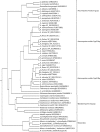Molecular Confirmation of the Linkage between the Rhizopus oryzae CYP51A Gene Coding Region and Its Intrinsic Voriconazole and Fluconazole Resistance
- PMID: 29891608
- PMCID: PMC6105841
- DOI: 10.1128/AAC.00224-18
Molecular Confirmation of the Linkage between the Rhizopus oryzae CYP51A Gene Coding Region and Its Intrinsic Voriconazole and Fluconazole Resistance
Abstract
Rhizopus oryzae is the most prevalent causative agent of mucormycosis, an increasingly reported opportunistic fungal infection. These Mucorales are intrinsically resistant to Candida- and Aspergillus-active antifungal azole drugs, such as fluconazole (FLC) and voriconazole, respectively. Despite its importance, the molecular mechanisms of its intrinsic azole resistance have not been elucidated yet. The aim of this work was to establish if the Rhizopus oryzaeCYP51 genes are uniquely responsible for intrinsic voriconazole and fluconazole resistance in these fungal pathogens. Two CYP51 genes were identified in the R. oryzae genome. We classified them as CYP51A and CYP51B based on their sequence similarity with other known fungal CYP51 genes. Later, we obtained a chimeric Aspergillus fumigatus strain harboring a functional R. oryzae CYP51A gene expressed under the regulation of the wild-type A. fumigatusCYP51A promoter and terminator. The mutant was selected after transformation by using a novel procedure taking advantage of the FLC hypersusceptibility of the A. fumigatusCYP51A deletion mutant used as the recipient strain. The azole susceptibility patterns of the A. fumigatus transformants harboring R. oryzae CYP51A mimicked exactly the azole susceptibility patterns of this mucormycete. The data presented in this work demonstrate that the R. oryzae CYP51A coding sequence is uniquely responsible for the R. oryzae azole susceptibility patterns.
Keywords: CYP51; Mucorales; Rhizopus; azole; fluconazole; intrinsic resistance; molecular mechanism; resistance; voriconazole.
Copyright © 2018 American Society for Microbiology.
Figures





Similar articles
-
The natural occurring Y129F polymorphism in Rhizopus oryzae (R. arrhizus) Cyp51Ap accounts for its intrinsic voriconazole resistance.Med Mycol. 2021 Dec 3;59(12):1202-1209. doi: 10.1093/mmy/myab052. Med Mycol. 2021. PMID: 34550395
-
Insight into the Significance of Aspergillus fumigatus cyp51A Polymorphisms.Antimicrob Agents Chemother. 2018 May 25;62(6):e00241-18. doi: 10.1128/AAC.00241-18. Print 2018 Jun. Antimicrob Agents Chemother. 2018. PMID: 29632011 Free PMC article.
-
Contributions of both ATP-Binding Cassette Transporter and Cyp51A Proteins Are Essential for Azole Resistance in Aspergillus fumigatus.Antimicrob Agents Chemother. 2017 Apr 24;61(5):e02748-16. doi: 10.1128/AAC.02748-16. Print 2017 May. Antimicrob Agents Chemother. 2017. PMID: 28264842 Free PMC article.
-
Exploring the molecular mechanism of azole resistance in Aspergillus fumigatus.J Mycol Med. 2020 Apr;30(1):100915. doi: 10.1016/j.mycmed.2019.100915. Epub 2019 Dec 6. J Mycol Med. 2020. PMID: 32008963 Review.
-
Resistance in human pathogenic yeasts and filamentous fungi: prevalence, underlying molecular mechanisms and link to the use of antifungals in humans and the environment.Dan Med J. 2016 Oct;63(10):B5288. Dan Med J. 2016. PMID: 27697142 Review.
Cited by
-
Serine/Threonine Phosphatase Calcineurin Orchestrates the Intrinsic Resistance to Micafungin in the Human-Pathogenic Fungus Mucor circinelloides.Antimicrob Agents Chemother. 2023 Feb 16;67(2):e0068622. doi: 10.1128/aac.00686-22. Epub 2023 Jan 23. Antimicrob Agents Chemother. 2023. PMID: 36688672 Free PMC article.
-
Whole genome analysis of Rhizopus species causing rhino-cerebral mucormycosis during the COVID-19 pandemic.Front Cell Infect Microbiol. 2023 Oct 31;13:1251456. doi: 10.3389/fcimb.2023.1251456. eCollection 2023. Front Cell Infect Microbiol. 2023. PMID: 38029246 Free PMC article.
-
A Novel Combination of CYP51A Mutations Confers Pan-Azole Resistance in Aspergillus fumigatus.Antimicrob Agents Chemother. 2020 Jul 22;64(8):e02501-19. doi: 10.1128/AAC.02501-19. Print 2020 Jul 22. Antimicrob Agents Chemother. 2020. PMID: 32423948 Free PMC article.
-
Analysis of the cyp51 genes contribution to azole resistance in Aspergillus section Nigri with the CRISPR-Cas9 technique.Antimicrob Agents Chemother. 2023 May 1;65(5):e01996-20. doi: 10.1128/AAC.01996-20. Epub 2021 Mar 8. Antimicrob Agents Chemother. 2023. PMID: 33685892 Free PMC article.
-
Diagnosis from Tissue: Histology and Identification.J Fungi (Basel). 2022 May 13;8(5):505. doi: 10.3390/jof8050505. J Fungi (Basel). 2022. PMID: 35628760 Free PMC article.
References
-
- Kontoyiannis DP, Lionakis MS, Lewis RE, Chamilos G, Healy M, Perego C, Safdar A, Kantarjian H, Champlin R, Walsh TJ, Raad II. 2005. Zygomycosis in a tertiary-care cancer center in the era of Aspergillus-active antifungal therapy: a case-control observational study of 27 recent cases. J Infect Dis 191:1350–1360. doi:10.1086/428780. - DOI - PubMed
-
- Kontoyiannis DP, Marr KA, Park BJ, Alexander BD, Anaissie EJ, Walsh TJ, Ito J, Andes DR, Baddley JW, Brown JM, Brumble LM, Freifeld AG, Hadley S, Herwaldt LA, Kauffman CA, Knapp K, Lyon GM, Morrison VA, Papanicolaou G, Patterson TF, Perl TM, Schuster MG, Walker R, Wannemuehler KA, Wingard JR, Chiller TM, Pappas PG. 2010. Prospective surveillance for invasive fungal infections in hematopoietic stem cell transplant recipients, 2001-2006: overview of the Transplant-Associated Infection Surveillance Network (TRANSNET) Database. Clin Infect Dis 50:1091–1100. doi:10.1086/651263. - DOI - PubMed
-
- Herbrecht R, Denning DW, Patterson TF, Bennett JE, Greene RE, Oestmann JW, Kern WV, Marr KA, Ribaud P, Lortholary O, Sylvester R, Rubin RH, Wingard JR, Stark P, Durand C, Caillot D, Thiel E, Chandrasekar PH, Hodges MR, Schlamm HT, Troke PF, B DePauw, Invasive Fungal Infections Group of the European Organisation for Research and Treatment of Cancer and the Global Aspergillus Study Group . 2002. Voriconazole versus amphotericin B for primary therapy of invasive aspergillosis. N Engl J Med 347:408–415. doi:10.1056/NEJMoa020191. - DOI - PubMed
Publication types
MeSH terms
Substances
LinkOut - more resources
Full Text Sources
Other Literature Sources

